 TRADITIONAL LIFESTYLE TRADITIONAL LIFESTYLE
Cameroon offers a wide diversity of customary traditions, and lifestyles; among those currently used, we could mention the following ones:
Among the Kapsiki, zebu´s skin is used by some mothers to carry their child on their back.
In the Centre, South and West , a cane basket is frequently used by women to carry farm products
Among Bamilekes, the perforated basket made of bamboo fibres can contain various objects.
In the North, potters make kitchen utensils from clay
In the Mandara region, polished calabashes are used as head-dress by young girls.
In Maroua, women have weaved cotton for centuries with the same ritual gestures.
In Mayo-ulla, craftsmen embroider with first class fabrics geometrical figures and arabesques.
 OTHER TRADITIONAL ARTS AND OBJETS OTHER TRADITIONAL ARTS AND OBJETS
Wood sculpture:
(Mahogany-tree, Sapelli, Ebony): panels of all dimensions showing images of everyday life, ornaments, and traditonal doors
Skin and Bronze:
casts and small boxes, game of chess, object of worship, spears, swords, knives, etc…
Pearl:
calabashes, canes, thrown and fetch-rest for kings, statues.
Fabrics:
embroided tablecloths , doily, tablemats
Rattan:
basket furniture
Clay:
piper and figurines
 PLASTIC ARTS PLASTIC ARTS
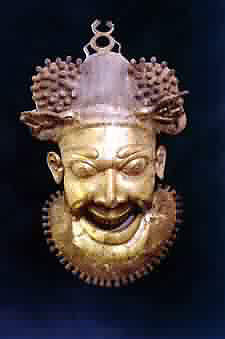
Kenfack Pascal:
Painter and woodcarver, he paints on large canvas, and generally carves on a large trunks of tree. In his painting, he uses pale colours whereas in his sculptures , he uses essential, complex and vivid forms. It is in the carving of trunks that he finds his expressive form. Masterpieces of his work include: youths and peace ; the struggle ; master initiation; spirit of twins; column of initiates; masked dance (the drummer) ; divines and bird-eating spider.
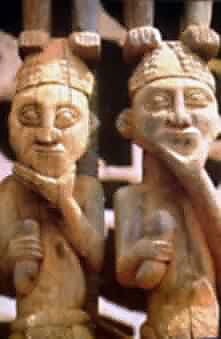
Kouam Jean:
Painter, his recurrent themes are: state of mind; symbology of ancestors; his techniques: acrylic colours with light laying, expressive form: abstraction and figuration with disposition of coloured spaces. His magazines,his works; “ l’écho du tam-tam intérieur", "le chant du sacrifice”.
Djilegong Etienne:
Woodcarver. He carves on Sapelli . His themes include village life , African myths and legends, solidarity, commitment of man in his community. His style, naturalist . His works: Bamileke village , the picking of fruits .
Tetang Nzoko Yacobou:
Painter and sculptor. Always in search of a new technique, and a new expressive form proper to him . His expressive form: close to surrealism, realities and imaginations superposed ; Coloured surface. His work: the woman of the land ; the fires and the waters; kora player.
Bang Blaise:
Painter. His themes: inspired from the society in which he lives . His expressive form: from abstract to figurative. His work: the cane and the totem ; the two bathers ; the totem eagle .
Otheo ( Ondigui Theodore Onana ):
Heterogeneous autodidact. His style: from 19th century Duverism to impressionist and cubist revolution . He has created synthetic and superposition form of traditional and modern technique . He uses obom ; a tree bark of different tints , manipulated in water and made supple like a fabric ; he uses that to make the gluing of symbolic subjects ; (.) His works: the crossing of the red sea ; the “word".
Youmbi Hervé:
Surrealist painter and sculptor. Theme: African myth , feeling and inner emotion . His works: the song of the forest ; the parrot .
Youmbi Pierre Emile:
Painter. Themes: rituals and ethnic traditions. His expressive form: enriched naivety ; technique: association of colours and traditional materials: raphia mats, bamboo. The whole, his painting is symbolic . His work: customary marriage .
Others artists assert themselves:
Joseph Sumegne (The Sense) ; Medza Siméon Didier (the African Woman) ; Zogo Isidore ( It’s Africa ); Etolo ( African Symbol) ; Ndi Thierry ( mintié be tara )
 MUSIC MUSIC
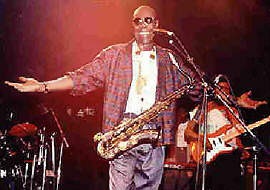
MANU DIBANGO
Manu Dibango, born Emmanuel Dibango N'Djocke in 1933 in Douala, Cameroon, is a true African international superstar.
Though his parents were both protestants, Manu was considered to be the child of a mixed marriage (his father is originally from the Yabassi people, meanwhile his mother from the Douala). Manu always felt that he was a divided man
.
"Born of two antagonistic ethnic groups in Cameroon, where custom is dictated by the father's origin, I have never been able to identify completely with either of my parents. Thus I have felt pushed toward others as I made my own path"
In the spring of 1949, when Manu was just 15, his parents sent him to Paris to prepare for a professional career. After twenty-one seasick days he reached Marseille. He waited for hours until his sponsor showed up; they boarded a crowded train for Paris where he was enrolled in a technical school at Saint-Calais. There, he completed his secundary education.
Soon Manu met Francis Bebey, another African expatriate, and together they began to explore the jazz scene in Calais. They started a band before they really knew how to play the instruments and learned as they went along.
Manu studied classical piano before taking up the saxophone around 1954. Two years later he moved to Brussels and played sax with various jazz bands. Once in Brussels Manu began to take off as a musician. He met Coco and within a year they decided to stay together, Manu still regards her as his "eternal guardian angel."
Together with Miriam Makeba and Youssou N’Dour, Manu Dibango is probably the most famous African musician. The multi-instrumentalist, composer, writer and producer was born in Douala (Cameroon) 64 years ago. Manu studied music in Paris and Brussels where he began to love jazz and then returned home. There he completed his knowledge of traditional African music. He combined these two musical movements to his individual style and had his first great success in 1972.
With the hit "Soul Makossa" he became known as Mister Makossa. This song sold more than 2 million records worldwide. Since then Manu has produced more than 20 records and has played with the most various musicians (among others: Herbie Hancock, Robbie Shakespeare, Sly Dunbar, MC Mello). Curious and equipped with great musical talent, Manu has never ceased being interested in the most various musical movements.
Apart from jazz he has included Reggae, Rumba, Samba and Rap into his music. His last CD "Waka Africa" which was his present for his 60th birthday is the peak of his musical journey until today. On this CD he is playing together with the stars of the African music scene such as Papa Wemba, Youssou N’Dour, Ray Lema, Angelique Kidjo and others.
"It’s music", he always comments on the tiresome question which elements would characterize his music. For his second appearance in Würzburg he wanted to be on stage with LuckyDube.
The albums of the soul Makosa Man / "Makossa Man" ( Atlantic ) produced in 1974 / "Gone Clear" ( Sono Disc ) produced in 1979 / "Live 91" (FNAC Music ) produced in 1991 / and do not forget the album that have definitively shown Manu as a bid star in the world of music: "Waka Afrika" ( FNAC Music ) that he has produced in 1994 / we would not forget the last opus of Sir Dibango "Papa Groove" signed (and produced with EMI ) in 1996.
More information about Manu and the rest @: jplanet@africanmusic.org
The African Music Encyclopedia: Music From Africa and the African Diaspora
 CINEMATOGRAPHIC ART CINEMATOGRAPHIC ART
After a glorious period at its beginning, Cameroon’s movie industry unfortunately failed to keep the pace by lack of financial support, among other reasons. For a few years now, and thanks to the efforts of a few artists, cinema survives while expecting a better future.
Among the most famous producers are:
Daniel Kamwa:
1) “Boubou Cravate” (short movie) inspired from a short story written by Francis Bebey. Theme treated is about cultural instability and the new African social class which is at midway between Africa and the West.
2) “Pousse pousse”, the first Cameroonian (long movie) Theme: Excesses in the practice of dowry.
3) “Cercle de pouvoir” Theme: corruption and
clientlism in the Cameroonian society.
Jean Pierre Dikongue Pipa:
“Muna Moto” (Somebody’s son). Theme: Dowry
Arthur Si Bita:
“No time to say good bye” (16 mn)
“Les coopérants” 1stlong movie
 ARCHITECTURAL ART ARCHITECTURAL ART
Pigmies use tree branches and leaves ; Mandara use stones and straw Bamileke; bamboo, straw and wood ; Peuls use clay and straw ; Mosgum use clay ; the peoples of the forest use raphia, bamboo and wood pegs.
The “ Mongulu” or pigmy hut
Circular and low-roofed, it is made up of tree branches, creeper fibres and foliage according to tree vegetation of the area. The “Mongulu” at its centre is not higher than a man’s height. It looks like a vegetal shell or like a big nose of a fallen bird.
The “hari” (compound) of Mandara
It is a mixture of stone and straw. Each “hari” has its own architectural design according to the ethnic group.
a) Sharp roof among the Matakram
b) Millet cloak protecting inhabitants among the Mofu
c) Strong walls and “hare” straw roof among the Kapsiki
d) Clay-coats wall among the Mozogo
Bamileke’s big hut:
Last refuge of pomp, power, excessiveness and order. Big huts are the cathedrals of Bamileke tradition. They are always built with sacred wood in their Bantu harmony of carved wood, surfaces showing multiform totemic animals, quiet and or grimming faces, geometrical figures. The diversity of the comical roof is made of straw.
The “saré” compound (Fulbé):
The housing is made up of clay and straw and respects strict and disciplined harmony. The “saré” are surrounded by straw walls the “sekkos” which undulate and in some places make narrow alleys under comical roofs.
The Bantu (of the forest ):
Local materials are used to build bamboo, wood, vegetal creeper, branch, raffía, palm-tree and clay houses. These houses are built along roads with wood pegs. They have a rectangular shape.
 CULTURAL EVENTS CULTURAL EVENTS
CAMEROON INTERNATIONAL THEATER FESTIVAL
The Cameroon International Theatre Festival (CITFEST) was founded in 1990 by the Cameroon Centre of the International Theatre Institute-Unesco. It was initiated by Ambroise MBIA, a Cameroonian actor and director who served as Secretary General of the Second World Black and African Festival of Arts and Culture (FESTAC), which took place in Lagos (Nigeria) in 1977 .
The main objective of CITFEST is to bring together every year men and women of theatre in order to promote exchange of ideas and concertation among them, and to create from these meetings a reflection with the goal of restoring peace and understanding in a world of perpetual conflicts.
It aims at promoting a theatre of research inspired by African customs and rites, and to establish a dialogue between its new values and the conventional dramatics technics. CITFEST also aims at developing a critical reflection on theatre within the context of the festival - colloquium on theatre - and to create a sustainable communication between African theatre artists and their foreign counterparts.
CITFEST promotes cultural exchanges through theatre. It is a place of exchange, concertation and dialogue between theatre artists and the whole world. It encourages the public and theatre practioners to participate in the exchange of ideas and in a universal dialogue through live performances.
AWARDS
CITFEST promotes stage productions of African plays at a very competitive level, challenging the artists and the audiences alike. At the end of each festival, there is an award ceremony to recognize actors and theatre groups of outstanding performance. Honorary distinctions, hommage and consecration are also awarded to theatre personalities from Africa and from all over the world
EDUCATION OUTPUTS
The Cameroon International Theatre Festival makes the audience be aware of the fact that theatre educates and leads to entertainment, relaxation and communication. In this regard, colloquia, symposia, roundtables, and exchanges between theatre artists and theatre personalities are organized during the festival, as well as training programs and worshops conducted by renown international experts.
ACHIEVEMENTS
In 1990, the first edition of CITFEST saw the participation of 15 theatre groups from Africa and Europe, as well as the presence from several personalities coming from Ivory Coast or France.
The second edition, held in 1991, brought together 17 theatre groups from Africa and Europe with guests from France, Germany and Spain
The third edition in 1992 brought theatre groups from Cameroon, Chad and Angola: a total of 23 dramas performances took place. Theatre personalities came from Belgium, France, Cyprus, the Netherlands, Sweden and Angola.
The fourth edition in 1993 had 27 drama performances given by troupes from Cameroon, Congo, the Central African Republic, Burkina Faso and Switzerland. Specials guests came from the United States of America, Romania, Germany, France, Congo, Niger, the Central African Republic and Burkina Faso
The fifth edition was held in 1996, and not in 1994, because of special cultural events in Cameroon. During that edition, 32 productions were presented by troupes from Cameroon, Chad, Greece, Uganda, and the Central African Republic. Special guests - theatre personalities - came from Belgium, Germany, Uganda and Greece.
|
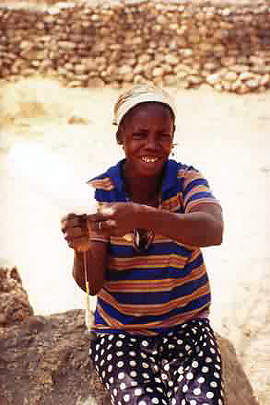
The sixth edition in 1997 had 27 drama performances presented by troupes from 12 countries: Cameroon, Kenya, Senegal, Chad, the Central Africa Republic, Ghana, Côte d'Ivoire, Belgium, Benin, Congo-Brazzaville, Germany, and Equatorial Guinea.
 IMPACT OF THE CITFEST IMPACT OF THE CITFEST
Since its inception CITFEST have got several short term scholarships for Cameroon theatre artists in Europe
African theatre troupes, selected during the festival, were invited to participate in a number international festival, namely, Les Journées Théâtrales de Carthage (Tunisia), the Gekleurd Festivaal (Netherlands and Belgium), the Tampere International Festival (Finland), le Festival de Théâtre européen de Grenoble (France), the Festival of New Theatre Discoveries for Europe in Mülheim an der Ruhr (Germany)
There is also a growing interest, especially from the European festival organizers and theatre directors who have participated in the Cameroon International Theatre Festival to negociate exchanges with African productions seen during the festival. This contributes to spread African culture worlwide. We note also a growing number of requests by foreign theatre directors to participate in the CITFEST NEW WAWE
Due to the growing succes of CITFEST, and as from the seventh edition (1998) performances will not only take place in Yaounde as formally, a pretty good number ar organised in Douala and Buea. These two cities have an impressive theatre going audience and have always put particular touch on theatre activities
Cameroon is a officially a bilingual country (French and English), and the extension of theatre festivities to other towns give the audience and theatre practionners an opportunity to identify themselves with the great festival assembly.
CITFEST
PO BOX 8163 Yaounde (CAMEROON)
Tel: (237) 22 47 85
Fax: (237) 23 30 22
OR SEND A MAIL TO esanja@mygale.org
 DRESSING ART DRESSING ART
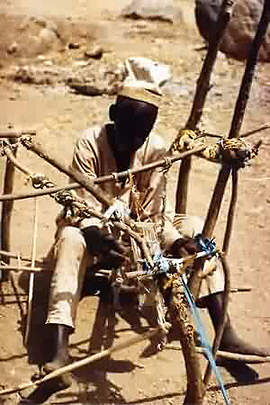
It shows the degree of taste for finesse and beauty in all tribes of Cameroon. Colours and embroideries, colours and lines follow each other and spread in the brightness of the dresses:
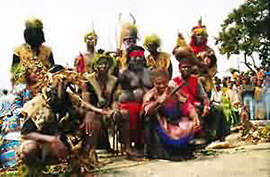
The Bamenda traditional robe, it distinguishes the inhabitants of the North-West from other Cameroonians. The dress is generally made of a combination of local materials. It is embroidered with varied bright colour threads and various patterns by skillful craftsmen
The pleated headdress of the “Dju-Dju” (master of ceremony among the people of Bandjoun)
the tso mask (West): beaded and moving
The bright hair pearls, necklace and bracelets of Oudjila girls (North)
Pearly belts and coloured linen of young Fali girls (North)
The Bamileke boubou is traditionally embroidered with reserves, thieck material designed with meandering raphia veins, which once loosened, reveal the geometrical stringency of traditional batiks
The glamour of the horsemen fantasia parade in North Cameroon where the most lively colours are superposed
Horses prepared (for the Fantasia) with silk gloves and silver plates
The loins fastened round the waist of patriarchs in the Centre, South and East provinces and their fly whisk
The “elephant men” (West) and their large dancing disc-ear masks as well as the long pearled panels portruding from their faces like elephant trunks
The “bird men” (West) ; large encircled with a halo of red feathers, opened like unbrellas, feathers of, ara, toucan, jays and a thousand birds with the most varied colours from the now protected Cameroonian forest. These enormous headdresses serve in the enthronement of chiefs or notables
The high pyramidal hair-style whose well-adjusted cylindrical shape above the head flares into several branches that support a large flat disc-like basketwork often covered with cloth
The “mekem” notables with their large skirts and tunics. These are royal cloths whose cross-line design are distinguished in white black and red braids which hang heavy on the edges
 TRADITIONNAL DISHES TRADITIONNAL DISHES
They have imposed themselves on the African continent and in most parts of the world.
 REGIONAL DISHES REGIONAL DISHES
a) Adamaoua: gruel and fufu corn;
b) North and Far North: gruel and ground millet;
c) West English speaking Cameroon: Achu, kwacoco;
d) West French speaking Cameroon: Yellow stew and pounded yams;
e) Littoral: Ndole, Mbongo, Miondo ;
f) Centre , South and East: Domba, groundnut soup, Nnam ngon, Sanga and Kpwem.
 DRINKS DRINKS
a) Centre , South and East: palm wine, Arki ;
b) French and English speaking West Cameroon: Raphia wine;
c) Adamaoua: maize Beer ;
d) North and Far North: millet beer ;
The entire country: the “odontol”
 THE GREAT ANNUAL FISHING WITH “DO” IN THE GLOYUA ETHNIC GROUP (ADAMAOUA) THE GREAT ANNUAL FISHING WITH “DO” IN THE GLOYUA ETHNIC GROUP (ADAMAOUA)
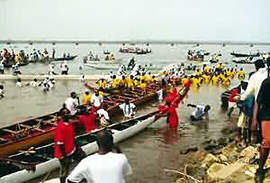
It takes place in March, and is the event that mobilises all GBAYA villages. “THE WABDO” a member of the secret society representing the GBAYA community leads the organisation. He is the one to give the signal to throw packets of “do” into the Mbere river. These packets are made up of barks and rounded plants which have a dizziness effect on fishes. When this mixture of barks and rounded plants is immersed, foam comes out of the water and all the river is covered with a white foamy layer. Fishes are therefore intoxicated, their eyes become brighter and they no longer have the sense of direction. The are left to the stream that carries them towards the dam and hurdles set up for the occasion. Baskets are filled with fish and fishing goes on until the effect of the “do” is over. The GBAYA people manifest their happiness. Fishes are dried and smoked by the river side before, there is a great feast in the village. The village chief having received an important share of the fish, offers a dish of fish to all villagers. Ancestors are not left out, they have a share to thank them for the fruitful fishing with the hope to repeat the exercise next year.
 THE “LELA” FESTIVAL IN THE SABI ETHNIC (North-West) THE “LELA” FESTIVAL IN THE SABI ETHNIC (North-West)
This is made up of many rituals carried out in the most important chiefdoms. Traditional dances are also performed in the fon’s palace for three months. During the festival, the Bali people wear their most beautiful attire , they sing special songs revealing their history and the beliefs of their ancestors, they visit some mystic sites, offer some donations. Sacrifices are made for ancestors so as to have more fishes, many births and less deaths the following year.
 THE NGON IN THE BAMOUN ETHNIC GROUP (WEST) THE NGON IN THE BAMOUN ETHNIC GROUP (WEST)
The great gathering of the BAMOUN people is organised under the leadership of the sultan, king. It is celebrated every two year. Up to now, the TIKAR people used to organised it every year to “settle land problems”. This feast has evolved from the beginning: first to pay tribute to the king, then to become a kind of “Bamoun sovereign national conference". The NGON is at the same time a cultural (ritual feast), (economic trade fair), fiscal (tribute to the king by the population), and political (settlement of matters of the kingdom).
 THE FEAST OF FISHING IN THE MASSA ETHNIC GROUP (FAR-NORTH) THE FEAST OF FISHING IN THE MASSA ETHNIC GROUP (FAR-NORTH)
Intermediary between god and man, the chief of the MASSA ethnic group organizes every year, a collective fishing in the YAERE. He therefore says a short prayer to MOUNDOUNFA the water spirit mother of mankind who looks like a yong lady with very long hair. The chief asks for her protection so that nobody should be harmed during the fishing and that the catching be fruitful. After this prayer he is the first to go into the water while on the river isde the crowd cry's proudly and then rush into the water. This given an extraordinary mixing up of people, harpoons, landing nets and traps of all kinds. The fishing has been fruitful and nobody is wounded. The chief very happy proceeds with the distribution of the fish and organizes a great feast marked by rituals to thank Mounounda the water spirit, and popular enjoyment all over the village.
 RHE NIAN NIAN IN THE BAFOUSSAM AND BALENG ETHNIC GROUP (WEST) RHE NIAN NIAN IN THE BAFOUSSAM AND BALENG ETHNIC GROUP (WEST)
The biannual ritual ceremony in Bafoussam and Baleng marks the transition between adolescence and adulthood ; you are not considered a woman when you have not gone through the NIAN NIAN ritual, what ever is your social statue. In Bafoussam, it is a nine weeks long manifestation that ends with a grand feast in the chief's palace (November-December). At Baleng, the ritual is organized at the end of every leap year (366 days).
In any case, candidates for the ritual go into the bush for nine (9) days with initiators. All this time, the most important dances of the village are executed every day on the chief’s yard. The Nian Nian comes out on the tenth (10) day and is closed by all kind of merry making.
 THE NGONDO IN THE SAWA ETHNIC GROUP (LITTORAL) THE NGONDO IN THE SAWA ETHNIC GROUP (LITTORAL)
This is the most colourful event on the Cameroon’s coast region. It takes place every year in December. One recalls the final issue of fights opposing Mabobe and Engomnga traditional fights which ended a dispute on navigation rights on a river in the littoral region. Furthermore, the Ngondo is an opportunity for Sawa people, people of the water to pay hommage to one of our founding and gathering element, namely water, that of the Wouri which dishes out every three or four years the “Mbea’a Toe”, the shellfish that gave its name to Cameroon. It is finally an hommage to deities that live in the sea: The Miengu half man half spirit, they reign on the ocean, the sea and rivers bringing prosperity to the Sawa people. The specialist JENGU gets into water with effort and stay under water for long and comes back dry at the surface with a basket given by the MIENGU. It contains sea flora and fauna objects. These objects constitute a message, an oracle for the coming year that specialists are going to interpret. The water feast ends in grand style with the arrival of the canoe race watched by thousands of spectators along the left side of the river Wouri and on the bridge. People therefore sing, dance and enjoy as they like, starting from the riverside and spreading all over the town. The Ngondo is some sort of Cameroonian Samba.
 THE FEAST OF THE RAM IN THE NYEM-NYEM ETHNIC GROUP (ADAMAOUA) THE FEAST OF THE RAM IN THE NYEM-NYEM ETHNIC GROUP (ADAMAOUA)
This is in fact one of the most original cultural event, the most extraordinary, by its artistic and mostly mystic nature. It is organized by the Nyem-Nyem ethnic group.These Mbororo from the Tchabbam Mbabo, conisdered as the highest over hangs the Adamaoua. During the spectacle rich in sounds and colours, young men play a music danced by those choosen by female partners standing on a line fifty meters away and run booking for their choice. The extraordinary touch is the participation of animals in the feast. Cows and bulls are moving exhilarated by the musical sounds, monkeys gesticulate with a challenging touch, boars move with their noses on the ground , wild horses hop and even oxen. The cohabitation is perfect between wild and domestic animals. The most extraordinary here is the fantasia with wild horses. In the afternoon young men go into the bush to look for wild horses, they capture them and bring back to the village for a final superb fantasia. After the fantasia , horses are immediately released to return to the bush, once again free to the nature.
 THE FEAST OF THE RAM AT FOUMBAN (WEST) THE FEAST OF THE RAM AT FOUMBAN (WEST)
An event particularly rich in colour with the solemn outing of the sultan king and his entourage wearing a ceremonial attire. A great event in its traditional and sports manifestation.
That ceremony is identical to the Ramadan. However it is more spectacular by its big march past-including those of waizard and secrete societies.
 THE WEEKLY FEAST IN FOUMBAN THE WEEKLY FEAST IN FOUMBAN
It takes place on Fridays during the great prayers. It is marked by mobilization around the much venerated sultan.
 INITIATION CEREMONY AND “KAK” DANCE (WEST) INITIATION CEREMONY AND “KAK” DANCE (WEST)
It is a biennial event that takes place in June and July. During a week, young people are initiated and practise initiatory dances. The ceremony ends with the great “Tso” dance that attracts many visitors.
 MASTERPIECE DAYS IN FOUMBAN MASTERPIECE DAYS IN FOUMBAN
They feature all aspects of Noun cultural and artistic life. Organized as a biennial, these days are marked by exhibitions of items for sale and by competitions wherein best artists in each domain are awarded prizes.
 THE FEAST OF THE DSCHANG COUNCIL (WEST) THE FEAST OF THE DSCHANG COUNCIL (WEST)
This event gathers all sons and daughters of the locality in order to make them evolve in various domains of life (craftsmanship, literature, music, economy, etc…)
 INTERNATIONAL DANCING DAY (WEST) INTERNATIONAL DANCING DAY (WEST)
It is organized by the provincal delegation of culture for the West and parts together the most represntative traditional dance group for a provincal dancing competition.
 NATIONAL FESTIVAL OF ART AND CULTURE NATIONAL FESTIVAL OF ART AND CULTURE
It takes place every December. It includes: music, theatre, dancing, arts, book exhibition and a great “Award” gala evening.
Lastly one can mention first of "Ekang" among the Beti , Ebang among the Ewondo of Yaounde, the Mbam art festival in Bafi and the Tikar cultural festival
|

